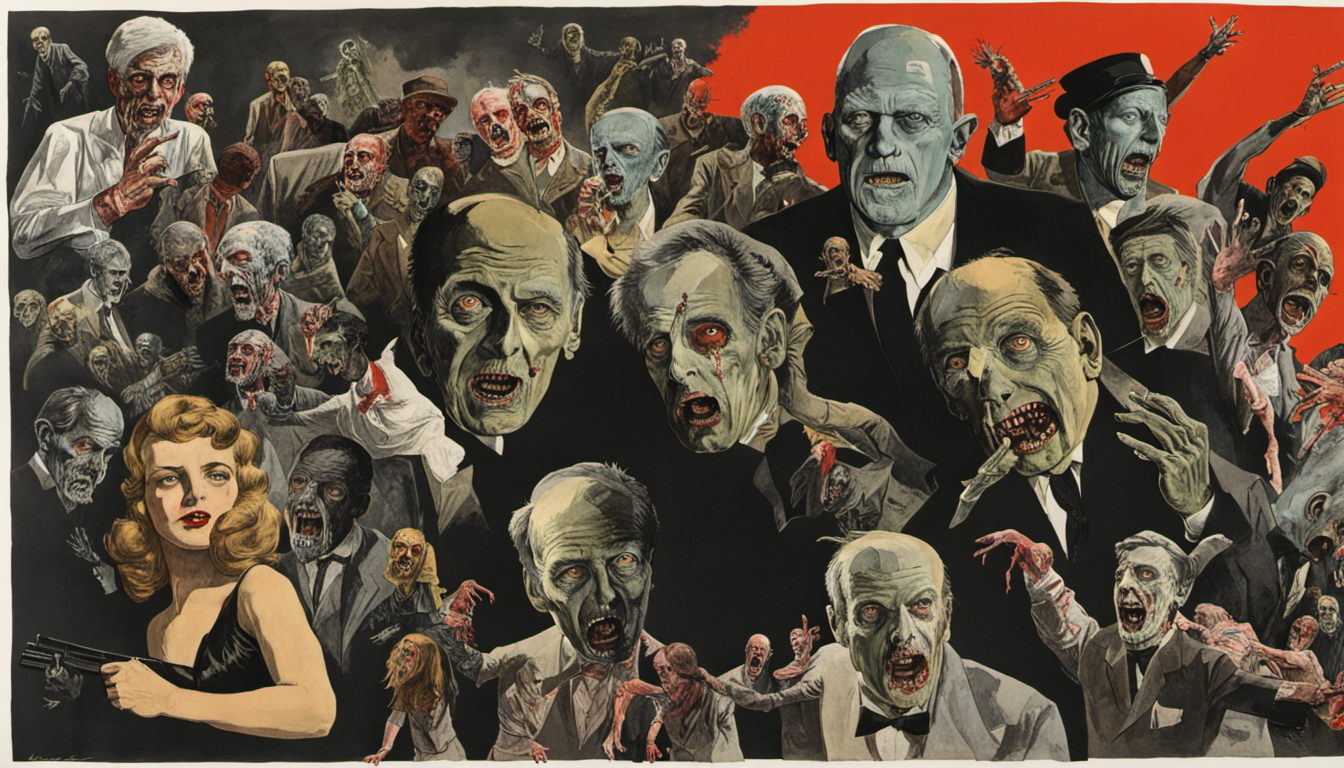
- Let’s see how we can use a trip to Rome and generative AI to show a glimpse of the future of Education.
- OpenAI’s CEO makes it crystal clear: “Jobs are definitely going to go away, full stop.”
- What’s the future of Q&A websites powered by human interaction? Stack Overflow traffic is down 40% year-over-year.
- The UK House of Lords is mildly concerned about the impact of AI on jobs. Only mildly.
- McKinsey believes that 29.5% of the hours worked in the US economy will be taken over by generative AI by 2030.
- Popular YouTube gamer Kwebbelkop transitioned to a synthetic version of himself running his channel.
P.s.: The Splendid Edition of Synthetic Work is out and it’s titled Your Own, Personal, Genie.
This week, we talk about what News Corp Australia, Wayfair, 3M Health Information Systems, Babylon Health, and ScribeEMR are doing with AI.
In the Prompting section, we discover that large language models might lose accuracy with larger context windows.
In the The Tools of the Trade section, we use LM Studio and the new Stable Beluga 2 model to create a personal AI assistant that runs on our computers.
My holiday lasted just two business days (plus the weekend). Of course, during this short break, an almost infinite number of things happened in AI-land. At least, we didn’t discover Artificial General Intelligence (AGI). Maybe for the Christmas break?
And of course, I found a way to connect my holiday with AI.
As a short break for my birthday, I went to Rome for some ghost hunting. The city was deserted and so I had an unprecedented chance to visit alone some of the most beautiful museums in the world. Below you see one of the pictures I took: a depiction of Medusa, one of the Gorgons, as we preserve it at the Musei Capitolini.

In this second picture, you see what happens when I use a fine-tuned version of the text-to-image AI model Stable Diffusion, called Realistic Vision, to bring it alive.

The model struggles to recreate the exact facial expression despite I conditioned the image generation with an advanced series of auxiliary models that go under the name of ControlNet.
I did this on a consumer hardware machine (a beefy MacBook Pro) over an afternoon of experiments. Given a much faster computer (aka a Windows machine with an NVIDIA graphic card) and enough time, I could probably do better. But the point is that experimentation is within reach for everyone.
In this third picture, I add a third AI model to help refine the quality of the picture, through a process usually called “HighRes Fix”.

The expression of the woman is even less faithful to the one captured by the statue. At the same time, the final image starts to look quite realistic. If used in schools, this image would certainly capture the imagination of the students way more than a white marble statue.
Imagine then, the possibilities if we animate the picture. We are getting there, with new AI models like Gen-2, developed by Runway, but the technology is not yet mature enough for me to animate this image without spending seven hours of experimentation.
Nonetheless, this is an exciting application for the Education industry. It will require quite a lot more automation to industrialize the process and bring down the costs, but generative AI gives us an unprecedented opportunity to bring history to life.
Notice that, at this point, I’m generating the static single picture through a complex process that involves five different AI models working together in a so-called pipeline.
When you use a commercial AI service like Adobe Firefly or Midjourney, much of this happens behind the scenes, as the owners of the service take many decisions on your behalf to make the process as simple as possible.
The more the decisions, the more constrained the results. This is why Midjourney can generate better images than its competitors, but refuses to deviate from the styles and compositions that you have seen everywhere on social media.
As a bonus, in this fourth picture, I’m using a new, alternative family of auxiliary AI models called UniControl. UniControl has the potential to surpass ControlNet in terms of quality and accuracy. The Stability AI team is already working to integrate the new Stable Diffusion XL model.

In particular, for this picture, I used the Colorization model that is part of UniControl.
As you know, ancient Greek and Roman statues were not really white, but painted to look more realistic. It was their version of photography.
So I thought that the Colorization model in UniControl could be evocative of that approach, even if the result is very far from how the original colors would have looked like.
Lots of (very technical) lessons learned in an afternoon of experiments. The most important thing that you need to know is that the people that you see sharing AI-generated images on social media are either true artists (exerting full control over the image generation by manipulating hundreds of settings) or image miners (generating thousands of images and pick the beautiful ones that came out with a bit of luck).
Either way, these people spend an absurd amount of time to show you the best of what AI can do today. It’s not a single-button-pushing process but, in many cases, a maze of staggering complexity.
If you want full control over what you are generating, today’s technology remains unapproachable for most people.
I’ll publish more pictures and experiments in the next few days (if I find the time) on social media. For now, let’s get back to AI and its impact on jobs.
Alessandro
The first thing that I have to put on your reading list is a new, very long profile of Sam Altman and OpenAI, for the Atlantic.
Among the other gems, Ross Andersen captures this quote from Altman:
I wanted to know how today’s workers—especially so-called knowledge workers—would fare if we were suddenly surrounded by AGIs. Would they be our miracle assistants or our replacements? “A lot of people working on AI pretend that it’s only going to be good; it’s only going to be a supplement; no one is ever going to be replaced,” he said. “Jobs are definitely going to go away, full stop.”
Even if you don’t want to be sensationalistic, it’s quite an arresting statement.
Two things come immediately to mind.
The first is that this statement connects the job loss to the arrival of Artificial General Intelligence (AGI). This characterization has implications.
Even if you believe Altman’s assumptions about the impact of AI on jobs, you still have to believe that his team, or somebody else, will get to AGI. And since it’s very hard to believe that we are getting close to AGI, the risk of job displacement seems very far away.
In reality, job displacement doesn’t need AGI, as we have documented for almost 6 months on Synthetic Work.
The second thing that comes to mind is that Altman just completed a world tour to meet with the governments of the world. It’s hard to imagine how even one of these governments would have skipped discussing the impact of AI on jobs.
If he said to them the same thing he said to the Atlantic, you’d expect that every single government in the world is working on contingency plans to deal with potential mass unemployment. And that it would become a key topic of discussion in the media.
But it’s not becoming a key topic of conversation.
So either the governments don’t believe there’s an urgency to act, perhaps because they don’t believe that AGI is around the corner, as I said above, or Altman has convinced them that this is a non-problem.
It might be the latter, as we find out in the article:
Altman imagines that far better jobs will be created in their place. “I don’t think we’ll want to go back,” he said. When I asked him what these future jobs might look like, he said he doesn’t know. He suspects there will be a wide range of jobs for which people will always prefer a human. (Massage therapists? I wondered.) His chosen example was teachers. I found this hard to square with his outsize enthusiasm for AI tutors. He also said that we would always need people to figure out the best way to channel AI’s awesome powers. “That’s going to be a super-valuable skill,” he said. “You have a computer that can do anything; what should it go do?”
This is one of the most problematic aspects of the debate on AI and jobs. For the most part, optimists have no problems admitting that existing jobs will be displaced, but they struggle to describe the new jobs that will be created. And this, in turn, creates an uncertain scenario that people find hard to be motivated by.
It’s called Blurred Vision Bias.
Many academic papers and business management articles have been written about the topic. If you are interested in learning more about it, and ways to address it, How can leaders overcome the blurry vision bias? identifying an antidote to the paradox of vision communication is a good starting point.
It’s not just a problem of blurred vision. The conditions that are fostering the adoption of generative AI are completely different from the ones that fostered the adoption of previous emerging technologies, as I described in the Intro of Issue #15 – Well, worst case, I’ll take a job as cowboy.
Sam Altman understands this better than most other optimistic AI commentators I’ve read online. Let’s continue the article:
The jobs of the future are notoriously difficult to predict, and Altman is right that Luddite fears of permanent mass unemployment have never come to pass. Still, AI’s emerging capabilities are so humanlike that one must wonder, at least, whether the past will remain a guide to the future. As many have noted, draft horses were permanently put out of work by the automobile. If Hondas are to horses as GPT-10 is to us, a whole host of long-standing assumptions may collapse.
Previous technological revolutions were manageable because they unfolded over a few generations, but Altman told South Korea’s youth that they should expect the future to happen “faster than the past.” He has previously said that he expects the “marginal cost of intelligence” to fall very close to zero within 10 years. The earning power of many, many workers would be drastically reduced in that scenario. It would result in a transfer of wealth from labor to the owners of capital so dramatic, Altman has said, that it could be remedied only by a massive countervailing redistribution.
In 2020, OpenAI provided funding to UBI Charitable, a nonprofit that supports cash-payment pilot programs, untethered to employment, in cities across America—the largest universal-basic-income experiment in the world, Altman told me. In 2021, he unveiled Worldcoin, a for-profit project that aims to securely distribute payments—like Venmo or PayPal, but with an eye toward the technological future—first through creating a global ID by scanning everyone’s iris with a five-pound silver sphere called the Orb. It seemed to me like a bet that we’re heading toward a world where AI has made it all but impossible to verify people’s identity and much of the population requires regular UBI payments to survive. Altman more or less granted that to be true, but said that Worldcoin is not just for UBI.
So, existing jobs will go away, but a wave of wonderful new jobs will arrive. Yet, we’ll need a massive countervailing redistribution of wealth to compensate the dramatic transfer of wealth. To the point that:
AI would still require considerable computing resources to run, and those resources would be by far the most valuable commodity, because AI could do “anything,” Altman said. “But is it going to do what I want, or is it going to do what you want?” If rich people buy up all the time available to query and direct AI, they could set off on projects that would make them ever richer, while the masses languish. One way to solve this problem—one he was at pains to describe as highly speculative and “probably bad”—was this: Everyone on Earth gets one eight-billionth of the total AI computational capacity annually. A person could sell their annual share of AI time, or they could use it to entertain themselves, or they could build still more luxurious housing, or they could pool it with others to do “a big cancer-curing run,” Altman said. “We just redistribute access to the system.”
Altman’s vision seemed to blend developments that may be nearer at hand with those further out on the horizon. It’s all speculation, of course. Even if only a little of it comes true in the next 10 or 20 years, the most generous redistribution schemes may not ease the ensuing dislocations. America today is torn apart, culturally and politically, by the continuing legacy of deindustrialization, and material deprivation is only one reason. The displaced manufacturing workers in the Rust Belt and elsewhere did find new jobs, in the main. But many of them seem to derive less meaning from filling orders in an Amazon warehouse or driving for Uber than their forebears had when they were building cars and forging steel—work that felt more central to the grand project of civilization. It’s hard to imagine how a corresponding crisis of meaning might play out for the professional class, but it surely would involve a great deal of anger and alienation.
Let’s stop here. We don’t focus on AGI on Synthetic Work. Not until it becomes a concrete possibility.
This is an exception to illustrate how mass job displacement is a real possibility in the mind of the people that are building our most capable AI models. And how too few people are talking about (and building) contingency plans for that scenario.
If you look at the progress made in less than one year by all sorts of generative AI models, you realize that the evolution of this technology is not showing a linear progression. Unless we hit a wall in terms of what machine learning can do, we are going to see extraordinary capabilities in the next two generations of models.
And by the way, Sam Altman is not the only one that expects the “marginal cost of intelligence” to fall very close to zero within 10 years.
One of the most accomplished venture capitalists in the world, Vinod Khosla, just last week, published a statement on Twitter X that is quite a departure from his long-standing recommendation for young people to learn STEM disciplines:
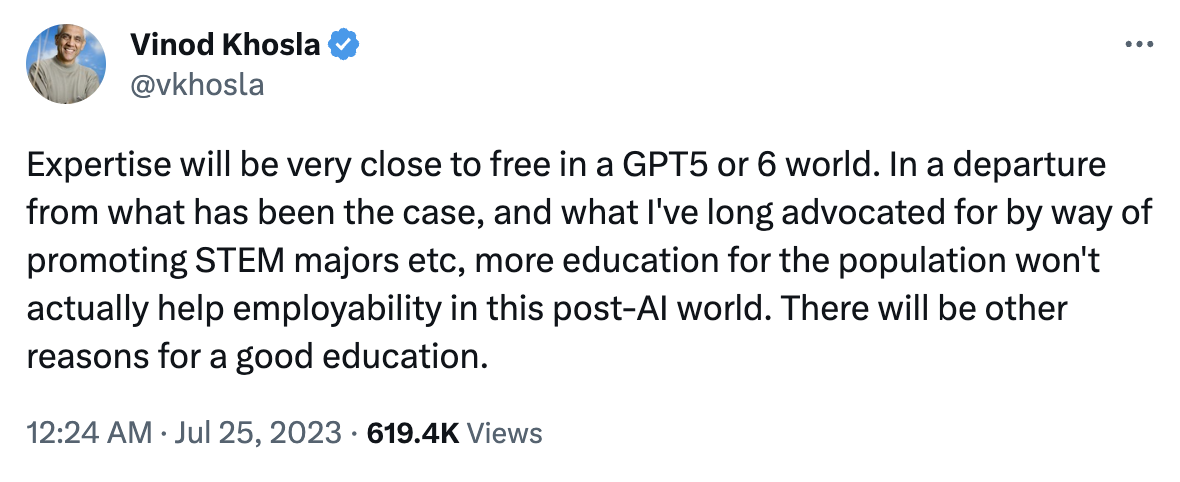
All of this is to say that contingency plans cannot wait. Not just at the government level, but also at the individual level.
- What are you doing to prepare for a potential takeover of some of your job tasks by generative AI?
- What are you doing to prepare children for an alternative reality where some of the jobs they are studying for will yield a much lower salary (or will disappear entirely) by the time they graduate?
- What are you doing to prepare your company against a hypothetical competitor that uses generative AI to recreate your business at a fraction of your cost?
A second thing worth your attention is an observation from Brett Winton, the Chief Futurist at ARK Invest (remember to always roll your eyes when you read that), about the decline in usage of Stack Overflow.
If you are not a technologist and you don’t know what Stack Overflow is: it’s a top Q&A website where developers, web designers, and data scientists go to ask technical questions about obscure technical issues.
Every generative AI startup developing large language models harvested Stack Overflow data to train their creatures at some point. That’s part of the reason why CoPilot, GPT-4 or Claude 2 are so good at answering questions about coding and data science.
But absorbing that knowledge (which is an improper description of what really happened, but let’s keep it simple) had a tangible impact on the usage of Stack Overflow.
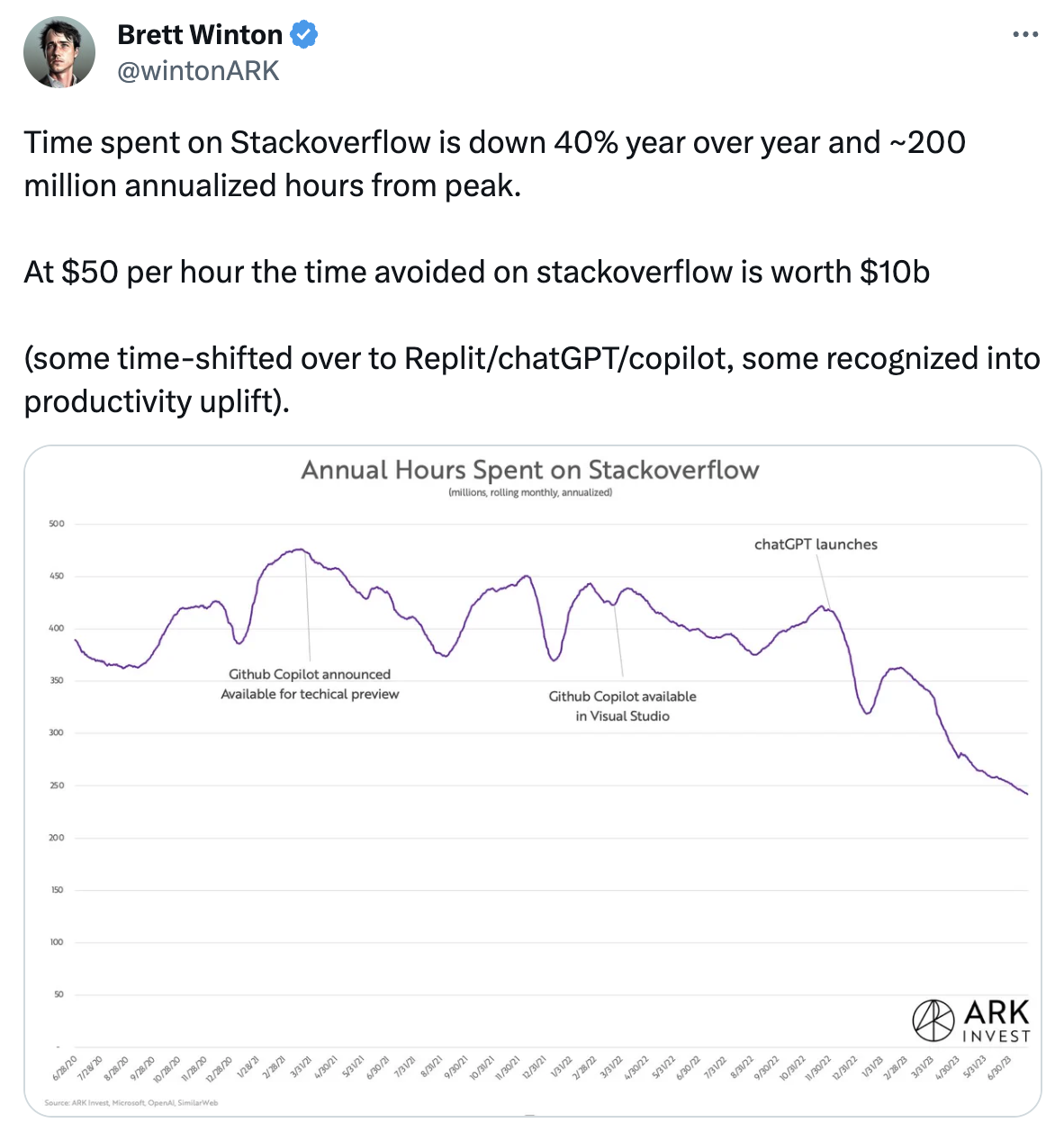
Take this as supporting evidence of how quickly, and dramatically, your business can be impacted by generative AI, and how quickly people can evolve the way they work.
Stack Overflow didn’t see this generative AI coming, and now they are doing the only possible thing: catching up as fast as they can. You can tell by the Labs label and the wording of the video below that this is not a fully backed service yet.
Much of this is already offered by CoPilot, which can do significantly more than Stack Overflow AI can. And potentially even more, in terms of integrations with corporate systems, will be offered by GPT-4 through its Plugin system.
Would you prefer to use a generic AI-powered Q&A platform that can answer any question you’d have about any topic? Or a specialized one that can only answer coding questions?
This is a question that every business out there will have: will users prefer to use my specialized AI or OpenAI generic AI?
It will boil down to how much better the specialized AI will be at answering questions. If your specialized AI model is only marginally better than a generalized model, users will prefer the convenience of interacting with a single model for everything.
This is why I keep stressing in all my consulting engagements that companies have to become really good at fine-tuning generative AI models. It’s the only way to stay competitive in the long run.
Back to Stack Overflow.
It’s also unclear how their user base will react to this new feature. There’s a difference between a third party harvesting your forum data in secret to commercialize your business killer, and you openly telling your users that their interactions are being harvested for you to profit from them without sharing the revenue.
As we said many times on Synthetic Work, we are all unknowingly contributing to the training of more and more powerful generative AI models. Every interaction we have with each other in the digital world is teaching these models how to generate more human-like and accurate text, images, sounds, voices, music, etc.
Not just the public interactions with have on cloud services like social media networks, but also within the boundaries of our companies, when we send emails, exchange chat messages, write documents, or participate in video meetings.
All of this data will eventually be used to train AI models that can write, sound, and look like us. But we are not getting paid for it.
So the question is: what and who else will experience that 40% year-over-year decline in usage?
Finally, if we zoom out from the specificity of the Stack Overflow situation, we might wonder if the advent of large language models will have a long-term impact on all websites that promote and depend on human interaction. And if that, in turn, will affect future LLMs.
If you feel particularly nerdy, you could read a new academic paper on this topic titled Are Large Language Models a Threat to Digital Public Goods? Evidence from Activity on Stack Overflow:
Large language models like ChatGPT efficiently provide users with information about various topics, presenting a potential substitute for searching the web and asking people for help online. But since users interact privately with the model, these models may drastically reduce the amount of publicly available human-generated data and knowledge resources.
This substitution can present a significant problem in securing training data for future models. In this work, we investigate how the release of ChatGPT changed human-generated open data on the web by analyzing the activity on Stack Overflow, the leading online Q&A platform for computer programming. We find that relative to its Russian and Chinese counterparts, where access to ChatGPT is limited, and to similar forums for mathematics, where ChatGPT is less capable, activity on Stack Overflow significantly decreased.
A difference-in-differences model estimates a 16% decrease in weekly posts on Stack Overflow. This effect increases in magnitude over time, and is larger for posts related to the most widely used programming languages. Posts made after ChatGPT get similar voting scores than before, suggesting that ChatGPT is not merely displacing duplicate or low-quality content.
These results suggest that more users are adopting large language models to answer questions and they are better substitutes for Stack Overflow for languages for which they have more training data.
Using models like ChatGPT may be more efficient for solving certain programming problems, but its widespread adoption and the resulting shift away from public exchange on the web will limit the open data people and models can learn from in the future.
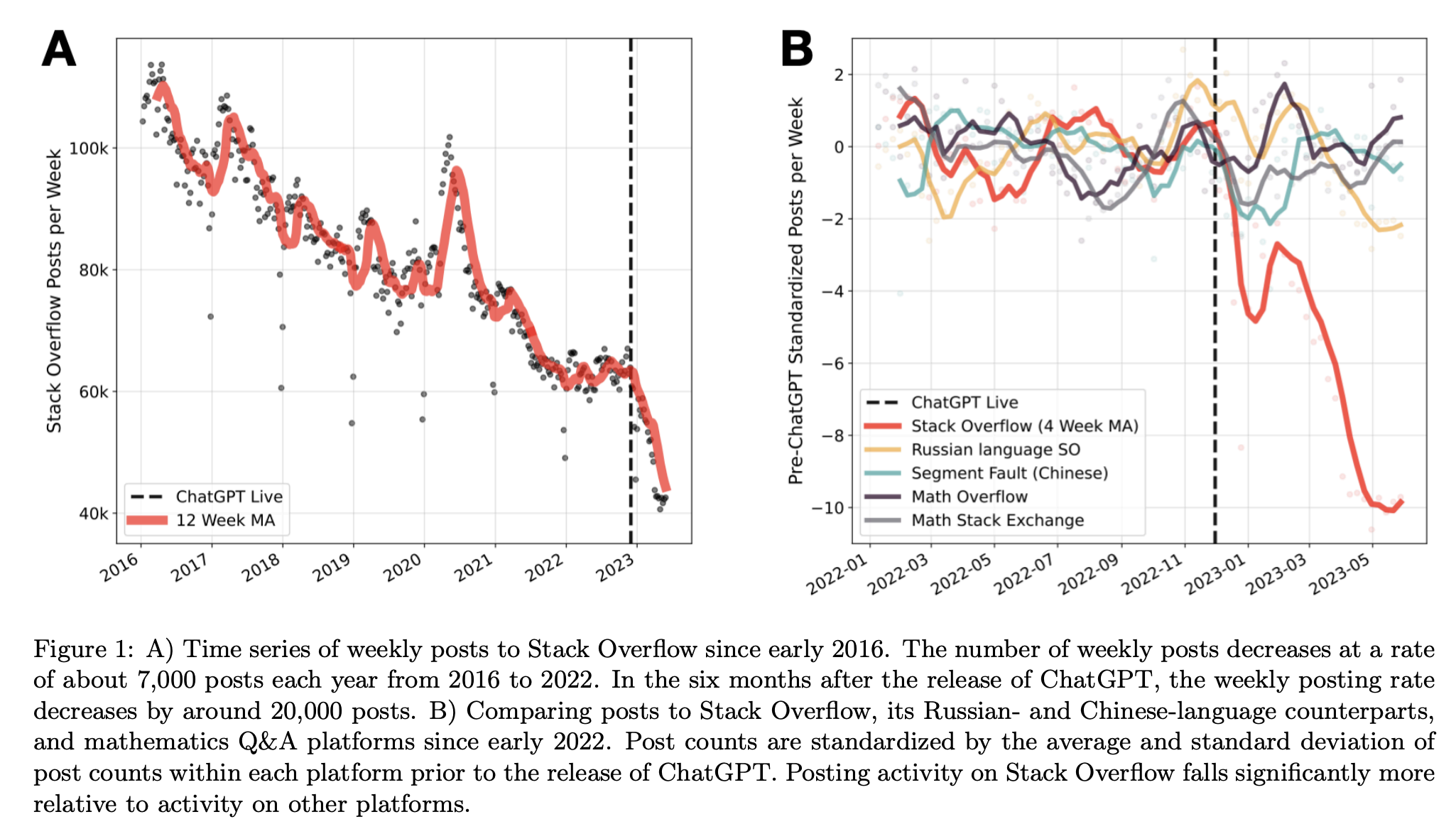
Connected to the first story of this week, the third story that caught my attention proves that some governments are mildly concerned about the impact of AI on jobs.
To tell us this story there is Safi Bugel, reporting for The Guardian:
The House of Lords could be replaced by bots with “deeper knowledge, higher productivity and lower running costs”, said a peer during a debate on the development of advanced artificial intelligence.
Addressing the upper chamber, Richard Denison hypothesised that AI services may soon be able to deliver his speeches in his own style and voice, “with no hesitation, repetition or deviation”.
He quoted the example to raise the wider issue of AI’s potential effect on the UK jobs market.
…
“Is it an exciting or alarming prospect that your lordships might one day be replaced by peer bots with deeper knowledge, higher productivity and lower running costs?” the independent crossbencher asked. “Yet this is the prospect for perhaps as many as 5 million workers in the UK over the next 10 years.“I was briefly tempted to outsource my AI speech to a chatbot and to see if anybody noticed. I did in fact test out two large language models. In seconds, both delivered 500-word speeches which were credible, if somewhat generic.”
That’s only because Lord Londesborough doesn’t follow the tutorials I publish in the Splendid Edition of Synthetic Work.
The Viscount Camrose replied, according to the article:
The AI minister, Jonathan Berry, said: “These advances bring great opportunities, from improving diagnostics and healthcare to tackling climate change, but they also bring serious challenges, such as the threat of fraud and disinformation created by deepfakes.
“We note the stark warnings from AI pioneers, however uncertain they may be about artificial general intelligence and AI biosecurity risks. We will unlock the extraordinary benefits of this landmark technology while protecting our society and keeping the public safe.”
This last statement encapsulates the feeling of most AI optimists: what we’ll gain out of this technology in terms of prosperity is worth the risk of losing our current jobs.
It’s an extraordinary position to take for humans, contrary to everything we see on daily basis. Our standard behavior, captured by the famous book The Innovator’s Dilemma, is that we don’t like to cannibalize their existing business in the hope of creating a much better one.
It’s hard to reconcile these two positions. Unless, of course, we don’t believe there will be any cannibalization.
You won’t believe that people would fall for it, but they do. Boy, they do.
So this is a section dedicated to making me popular.
Just last week, McKinsey published a new report dedicated to Generative AI and the future of work in America:
Across a majority of occupations (employing 75 percent of the workforce), the pandemic accelerated trends that could persist through the end of the decade. Occupations that took a hit during the downturn are likely to continue shrinking over time. These include customer-facing roles affected by the shift to e-commerce and office support roles that could be eliminated either by automation or by fewer people coming into physical offices. Declines in food services, customer service and sales, office support, and production work could account for almost ten million (more than 84 percent) of the 12 million occupational shifts expected by 2030.
By contrast, occupations in business and legal professions, management, healthcare, transportation, and STEM were resilient during the pandemic and are poised for continued growth. These categories are expected to see fewer than one million occupational shifts by 2030.
…
The biggest future job losses are likely to occur in office support, customer service, and food services. We estimate that demand for clerks12 could decrease by 1.6 million jobs, in addition to losses of 830,000 for retail salespersons, 710,000 for administrative assistants, and 630,000 for cashiers. These jobs involve a high share of repetitive tasks, data collection, and elementary data processing, all activities that automated systems can handle efficiently. Our analysis also finds a modest decline in production jobs despite an upswing in the overall US manufacturing sector, which is explained by the fact that the sector increasingly requires fewer traditional production jobs but more skilled technical and digital roles.We estimate that 11.8 million workers currently in occupations with shrinking demand may need to move into different lines of work by 2030. Roughly nine million of them may wind up moving into different occupational categories altogether. Considering what has already transpired, that would bring the total number of occupational transitions through the decade’s end to a level almost 25 percent higher than our earlier estimates, creating a more pronounced shift in the mix of jobs across the economy.
Long-time readers of Synthetic Work know how I feel about this kind of forecast. Also, this is in stark contrast with many other studies we discussed before, suggesting that the legal profession will be one of the most impacted by AI.
Among the others, you can review How will Language Modelers like ChatGPT Affect Occupations and Industries?
Yes, I’m building a new Research section of Synthetic Work to aggregate all the most important research on the impact of generative AI on jobs. It’s for situations like this one, when we need to refer to an important study and we can’t waste hours going through the archives of the newsletter.
It’s still a work in progress, which is why there’s no link from the front page and no official announcement.
But we are digressing.
The money quote from the report:
Without generative AI, our research estimated, automation could take over tasks accounting for 21.5% of the hours worked in the US economy by 2030. With it, that share has now jumped to 29.5%.
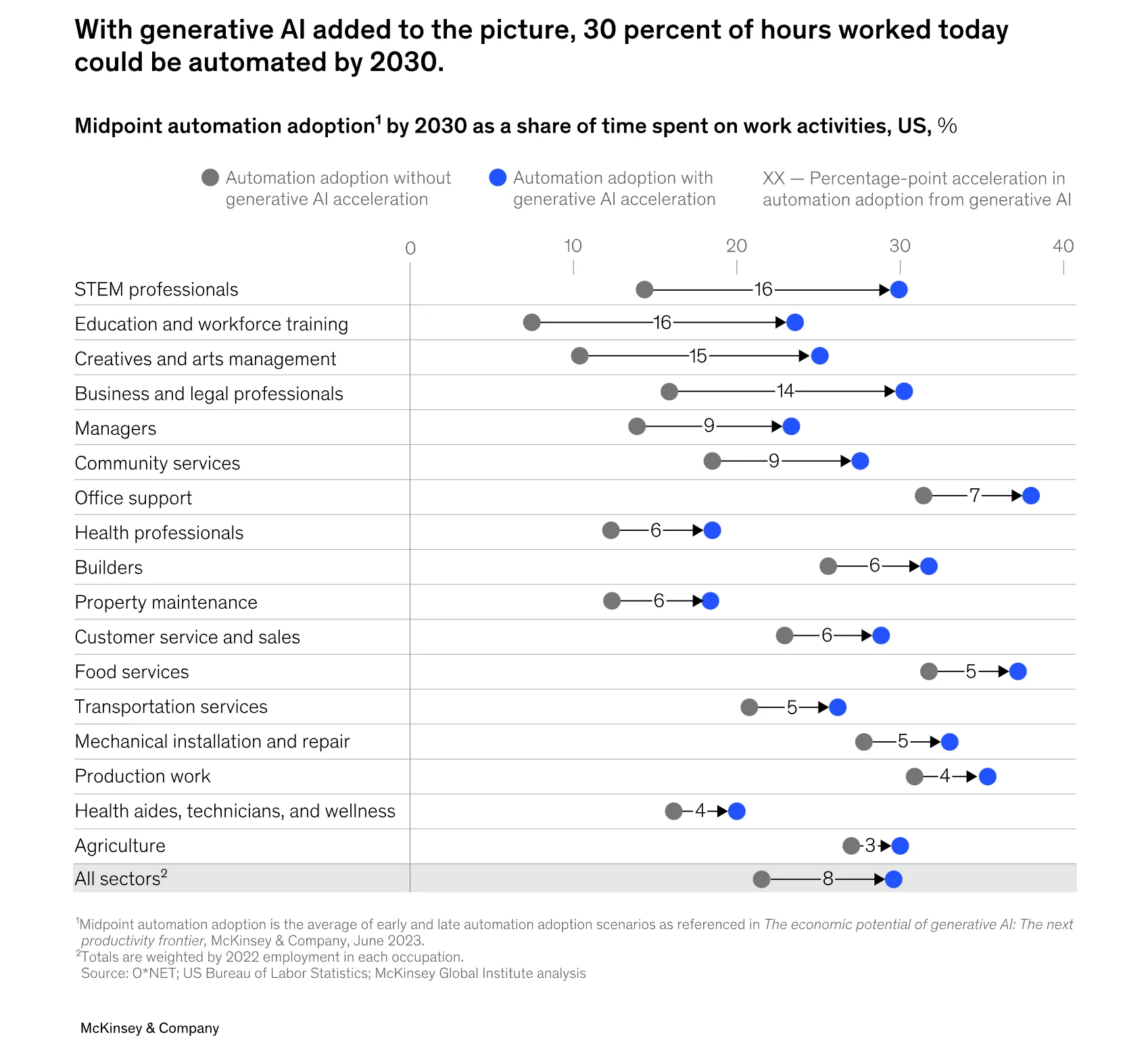
After dedicating an entire career to automation, I could talk for hours about how the first part of this prediction seems exceptionally unrealistic. But if we decide to believe Sam Altman then we might decide to believe McKinsey, too.
Let’s continue:
This research does not predict aggregated future employment levels; instead, we model various drivers of labor demand to look at how the mix of jobs might change—and those results yield some gains and some losses. In fact, the occupational categories most exposed to generative AI could continue to add jobs through 2030, although its adoption may slow their rate of growth. And even as automation takes hold, investment and structural drivers will support employment. The biggest impact for knowledge workers that we can state with certainty is that generative AI is likely to significantly change their mix of work activities.
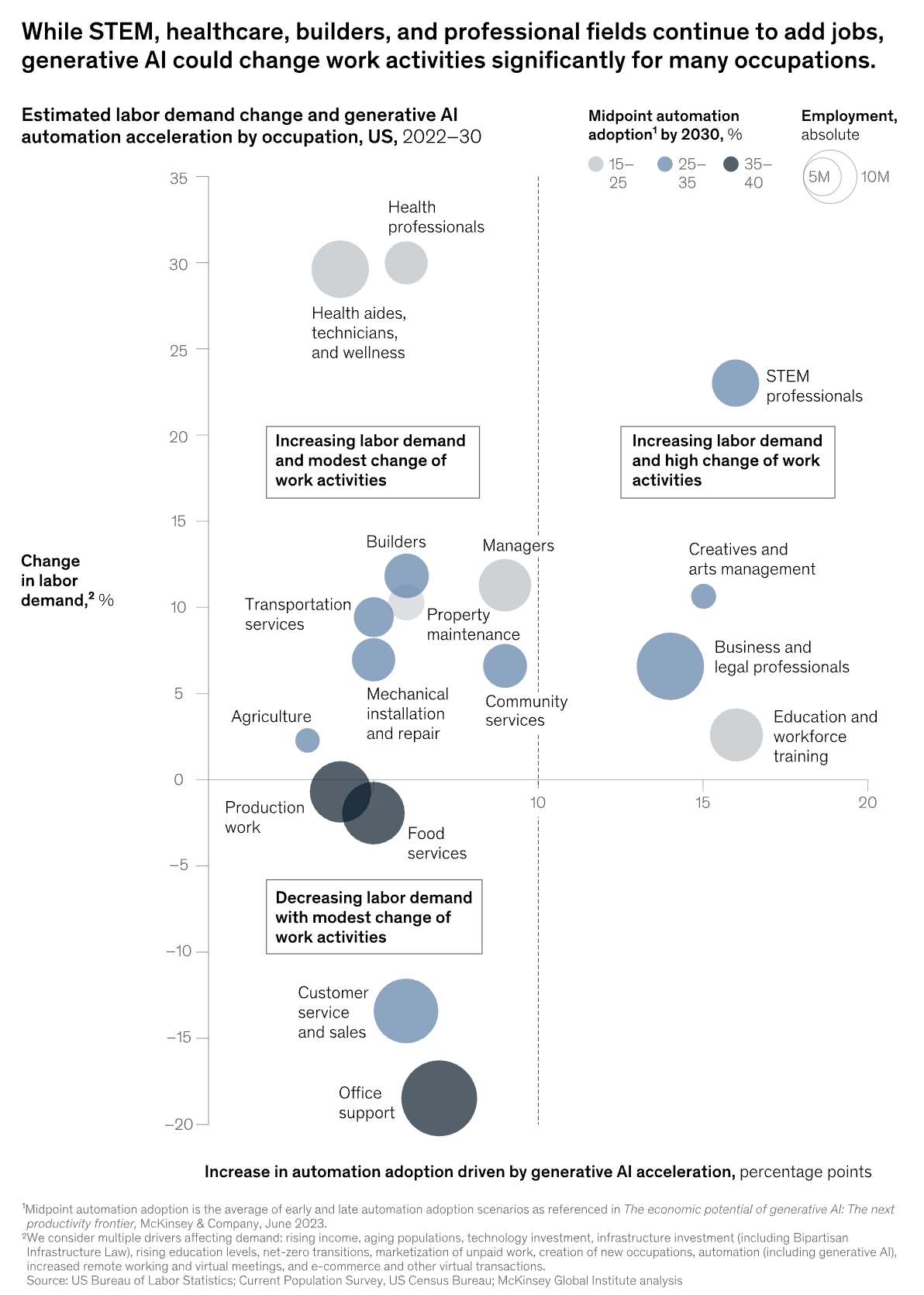
The thing that is truly unclear in this report is if McKinsey has modeled this outcome accounting for linear, exponential, or null progress of generative AI models.
For example, did they consider that by 2030 we’ll have GPT-5 and GPT-6, and each might be overwhelmingly more capable than its predecessor? Or did they assume that progress will freeze to GPT-4 capabilities expected by the end of the year?
That makes a huge difference in terms of how to interpret this forecast.
Reviewing the Methodology section of the full 76-page report reveals nothing.
The one takeaway from this study is that there is no consensus among forecasters and experts on how big the impact of AI will be on jobs, and on which kind of jobs.
This is (hopefully) why you read Synthetic Work: to develop an independent and balanced opinion on the topic, while we figure out who’s right.
This is the material that will be greatly expanded in the Splendid Edition of the newsletter.
As we anticipated a few issues ago, synthetic clones of ourselves are coming and, if you believe the survey recently made by YouTube, people won’t have a problem if they replace real human entertainers.
Chris Stokel-Walker, reporting for Wired:
Jordi Van Den Bussche used to devote every waking hour to building his presence on social media. The gaming creator, better known as Kwebbelkop, would labor 24/7 on his YouTube channel coming up with video ideas, shooting them, distributing them. He did this while courting brand deals and doing the other work integral to his survival on the platform. Five years ago, he ran into a problem. “Every time I wanted to take a holiday or I needed some time for myself, I couldn’t really do that, because my entire business would stop,” he says.
…
It’s an issue known as the “key person problem.” Without Van Den Bussche on camera, the entire Kwebbelkop enterprise didn’t work. He was too busy making videos to think about how to scale his business, and too tired to create videos. He needed a break: Around 2018, like many other YouTubers, he experienced significant burnout.
…
The burnout sparked a change in mindset. He began thinking about what would benefit him and what would benefit the creator industry—which often relies on milking the on-camera presence of an individual until they reach a breaking point, then finding another person seeking fame and fortune. He came up with a solution: a series of AI tools designed to create and upload videos, practically without his involvement. “I’m retired from being an influencer,” he says. “I’ve had a lovely career. I had a lot of fun. I want to take things to the next level. And that means making this brand live on forever.”
…
Van Den Bussche’s AI influencer platform, which launched this week after a suitably excitable level of hype on Twitter from its creator, is his attempt to make that happen. It comprises two versions of an AI tool. The first is trained on a creator’s likeness—their on-camera performances and what they say in videos—and is used to create new content. It appears to be similar to Forever Voices, the controversial AI tool behind the CarynAI virtual influencer, which outsourced maintaining connections with fans on behalf of creators.The other involves simplifying the act of creation as much as possible by taking simple prompts—such as “turn this article into a video formatted like an interview involving two people”—and producing the end result. (The latter is similar to a tool called QuickVid, which has seen some early adoption.)
Long-time readers of Synthetic Work know that, since day one, I recommended to not think about generative AI assistants like GPT-4 as very capable interns, an analogy that you see regurgitated over and over on social media and the press.
I always recommended thinking about an AI assistant as the most talented actor in Hollywood. You, the user, are the director.
Jordi Van Den Bussche, the protagonist of this story, is effectively transitioning from being an actor to being a director.
Let’s continue the article:
The ideas that went into the AI tools took years to form. Prior to building them, Van Den Bussche had set up a coaching business, where he gave other aspiring influencers his blueprint for social media success. It was through that process that he developed a protocol for how to be a prominent creator. Eventually, though, even his protégés needed time off, and Van Den Bussche realized the fatal flaw in the creator economy was humans.
…
Van Den Bussche and his creative team began trying to reverse engineer what made creators successful. “We started testing a lot of theories on this,” he says. “We needed evidence: How much does the voice influence the performance with the fans? How much does the face influence it? How much does the content influence it?”In April 2021, Van Den Bussche launched a YouTube channel with a virtual YouTuber (vtuber) called Bloo that he developed, powered by AI. Since then, Bloo has gained 775,000 subscribers, with each video watched by tens of thousands or hundreds of thousands of viewers. “He’s a completely virtual influencer with a protocol and set steps and a bunch of AI and machine learning applications involved in the system,” he says. “Now we’re applying that model to my IP and my friends’. It includes voice cloning, so it sounds like me.”
The Kwebbelkop videos made by AI—the first of which dropped on Tuesday—are powered by models trained on Van Den Bussche’s existing content. “It’s modeled after me and my creativity and my input,” he says. “Everyone thinks I’m retiring as a creator and letting this AI run, but I’m not retiring as a creative.”
…
He claims to have a wait list of 500 influencer friends within the industry eager to adopt his AI tools, though he can’t give them access until the cost of creating new videos drops to an economical level, which he believes will happen as technology advances.
This is a video of Bloo:
This, instead is a video of synthetic Van Den Bussche:
Of course, once the process of creating a synthetic influencer becomes automatable and cheap, an already saturated platform like YouTube will become 1000x more crowded. Which means that, to stand out and capture more than a few users, each synthetic influencer owner will have to spend bigger and bigger budgets on advertising and marketing.
Unless we start doing the reverse: rather than capturing as much audience as possible, we start capturing the smallest possible niche, but at scale. A company like Meta could create millions of synthetic entertainers, exquisitely tailored around the unique taste of each user (of which, they know everything about).
What does make you you?
And what do people want to see from you specifically for them to pay enough to earn a living?
Going forward these questions will become more important than ever.
What if the only two jobs of the future will be building for others and entertaining others?
The time has come for us to start testing open access and open source large language models. These models have reached a level of maturity that starts to match the performance of GPT-3.5-Turbo in some tasks and, at this pace, we might see them getting close to GPT-4 level of performance by the end of the year.
There are many reasons why you’d want to pay attention to these models.
Perhaps because your company doesn’t want to depend on a single AI provider like OpenAI, Anthropic, or Microsoft. The more capable their models become, the more they will be able to charge for them.
Perhaps your company doesn’t want to depend on an AI model that can wildly fluctuate in terms of accuracy over time. You may have read the heated debate between OpenAI and its customer base about the dramatic drop in accuracy of both GPT-3.5-Turbo and GPT-4 from March to Now.
Perhaps your company wants to build a product on top of AI providers’ APIs but the cost is exorbitant for the use case you have in mind, making the whole business financially unsustainable.
Perhaps your company wants to fine-tune an AI model but you don’t feel comfortable sharing your precious proprietary data with an AI provider or you don’t want to wait for them to make the fine-tuning process easy and accessible (right now it’s more akin to a consulting engagement for most companies).
Perhaps your company wants to achieve a level of customization that is simply impossible to achieve with the security scaffolding that the AI providers have put in place to protect their models from prompt injections, reputational risks, and other potential liabilities.
We can go on for a while.
The point is that, at least in this early stage of technology evolution for generative AI, you may want to keep all your options open.
Just last months ago, in the text-to-image (more properly called diffusion) models space, it seemed that nobody could beat Midjourney. To enjoy their frictionless generation of stunning AI images, you would have to accept the lack of flexibility in image composition and final look & feel. Because the alternative was a less-than-impressive quality produced by alternatives like Stable Diffusion and Dall-E 2.
Then, Stability AI released Stable Diffusion XL (SDXL) and everything is worth reconsidering now.
The same might happen with language models and the current dominance of GPT-4.
To understand how much these models have matured, we’ll test a version of the new LLaMA 2 70B model released by Meta, and fine-tuned by Stability AI.
